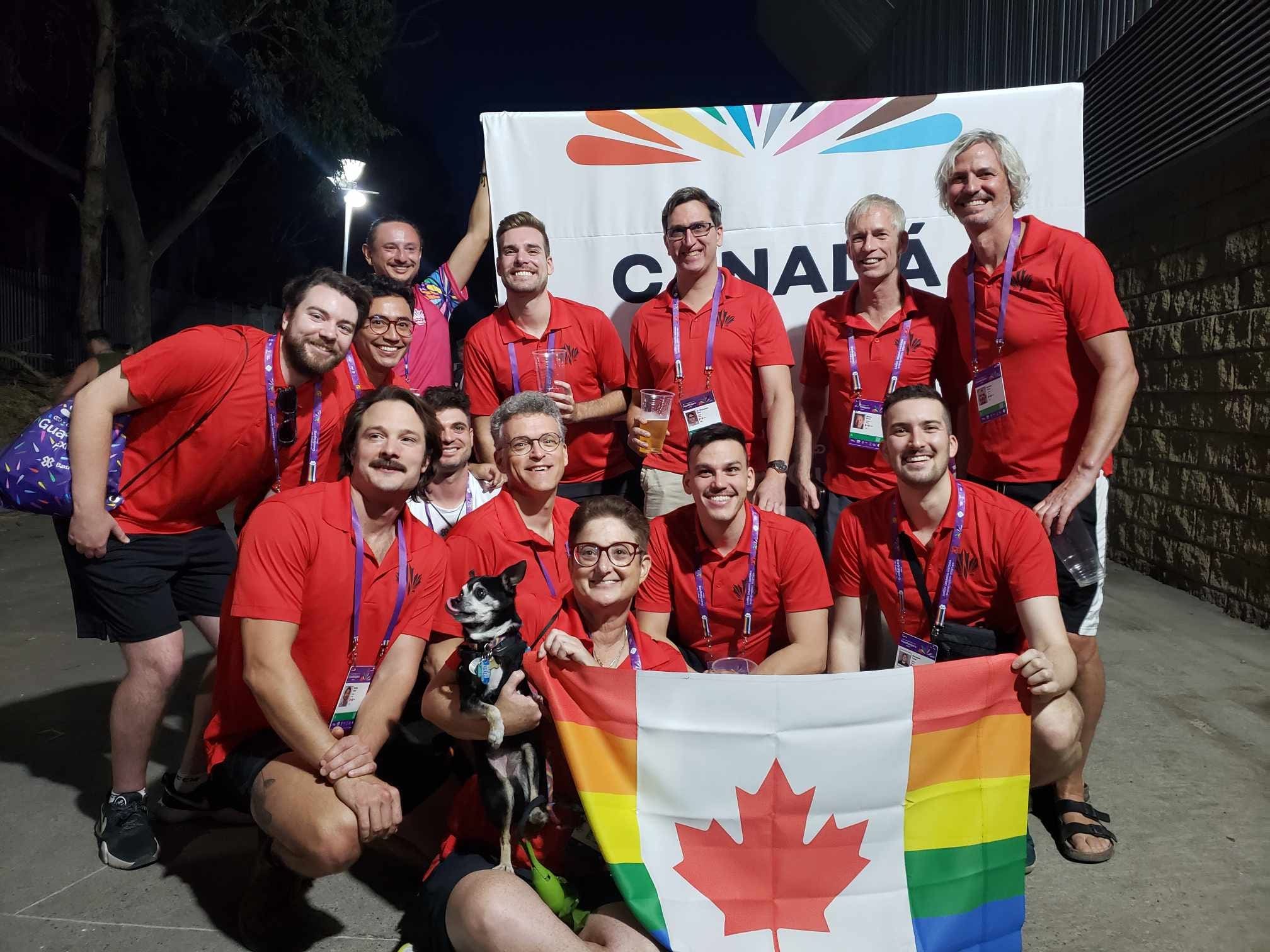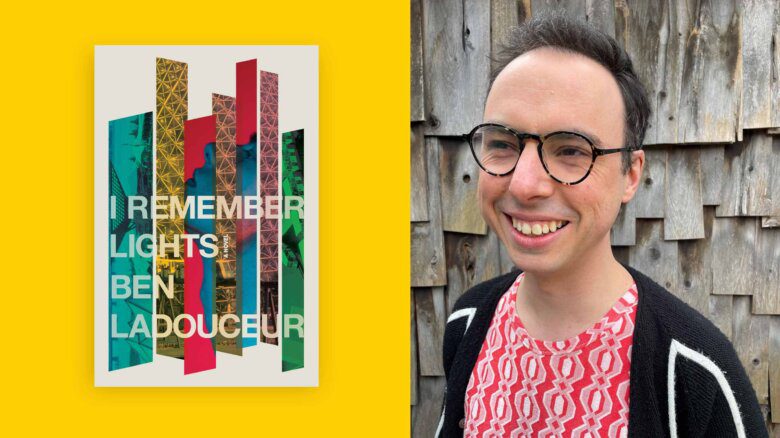Jon grew up without learning how to swim and didn’t know it was possible to start at age 30. “Growing up, I didn’t feel comfortable swimming. I think a lot of gay people didn’t, because the locker room didn’t feel like a safe space,” he says. (Some interviewees in this article, including Jon, chose to use their first names only due to privacy concerns.)
When he decided it was time to get in the pool, Jon thought his only hope was to search “how to swim” on Google or YouTube. Then a co-worker introduced him to the Rideau Speedeaus, Ottawa’s inclusive masters swim club, where he met Peter—a member who learned to swim at 60, and Marie-Lynne, the club’s learn-to-swim coach.
“I definitely want to be a better swimmer,” Jon says. “I joined mostly for that. But the huge plus is the fun we have.” This includes post-practice dinners and group chats that have nothing to do with training schedules, he says.
Across the U.S., and increasingly in parts of Canada—such as Alberta, where new legislation will restrict trans athletes from participating in female sports divisions—the inclusion of trans and non-binary athletes in competitive sport is being fiercely debated. In the face of that, inclusive LGBTQ2S+ recreational leagues like the Speedeaus offer something that should be simple but isn’t: a place where everybody can feel safe, welcome and free to participate.
For Guylaine Demers, a professor in Laval University’s department of physical education, a 2024 inductee into Canada’s Order of Sport, and a leading voice in gender equity in sport, this matters. Demers points out that most public conversation about sport centres on elite competition such as Olympic policies, world championship bans and international federations. “Sometimes the only input we get is from the high performance,” she says. “Which has nothing to do with the majority of people who just want to play sport.”

Members of the Rideau Speedeaus gather for the Gay Games. Credit: Courtesy of Rideau Speedeaus
Certainly for Jon, learning to swim at age 30 was never about aiming for the Olympics. But his story reflects something deeper that many of his fellow Speedeaus—some of them former elite athletes—also speak to: the chance to begin, or to begin again.
Former international-level swimmer and current Rideau Speedeaus president, Tarek Raafat, acknowledges there was a time when homophobia would have made him “terrified” to be associated with a queer swim club. “I actually stopped swimming for ten years. I was at a low point in my life, and I’ve always loved swimming, so I decided I would join the Speedeaus.” He’s now been the club president for eight years.
Similarly, Speedeaus member Alex quit his childhood sports of swimming and hockey, and for years, stayed away. Then, he found Ottawa Pride Hockey. “It really changed my perspective on doing sports as an adult and as someone who’s gay myself. It took away all that toxic aspect that felt present for me in hockey. And I thought, ‘If I can do that for hockey, fall back in love with the game, maybe I can do that with swimming as well.’” A year later, Alex says, “Joining this team, it feels like coming back home.”
This is what LGBTQ2S+-inclusive leagues make possible: a chance to reclaim and experience sport in a safe and joyful way.
It’s something Jason Evanochko, founder and president of Saskatoon’s inclusive Prairie Lily Curling League embodies. What started back in 2013 as an attempt to form a single team to compete in the Canadian Pride Curling Championships has turned into a way of life. The league —now boasting 32 teams—is Canada’s fourth-largest queer curling league and has won, and hosted, the national championships.
Founding Prairie Lily has kept Jason deeply involved with curling, while letting him offer that same opportunity to others. Learn-to-curl programs and free equipment rentals remove barriers to new curlers, and the league has recently supported a spin-off queer lawn bowling club.

Members of the Prairie Lily Curling League in action. Credit: Courtesy of Prairie Lily Curling League
While these leagues help strengthen participants’ relationship with their sports, Demers says something deeper can also be happening. In a newly published research report, Demers’s team heard from trans and non-binary youth in Quebec about the benefits of staying in sport. Youth who had recently undergone gender transition described sport as a key part of that experience. “They were telling us—those for whom the transition went smoothly—sport was a key aspect of that smooth transition. Accepting yourself, accepting your new body, accepting how your new body is moving.”
Brent Bauer, a Rideau Speedeaus member for nearly 25 years, joined the club after moving from Montreal to Ottawa in the early 2000s—a time, he recalls, when it felt harder to live openly as a gay man in his new city. “I’ve seen, over the past couple of decades, different individuals come to the club at different moments in their journeys, whether coming out or transitioning or exploring their sexuality or in recovery, and it’s been a very powerful therapeutic tool to get them through certain times—as it was for me.”
This idea of LGBTQ2S+-inclusive sports leagues as places that can heal and help is supported by the Prairie Lily Curling League’s if-you’re-here-you’re-welcome philosophy. “You can’t question people,” Jason says. “You never know. Maybe they, themselves, are questioning or unsure. Maybe this is a way for them to break the ice for their kids, or learn how to be comfortable.
“That’s our goal, at the end of the day: making sure that everybody feels safe,” he adds.
Rafaat says in the face of intolerance and external threats, the importance of LGBTQ2S+-inclusive sports spaces can’t be underestimated. “A few years ago, you would hear a lot of people say, ‘Oh, well, I can just swim with a regular swim team.’ But in light of how fragile that acceptance is, it’s important to have a safe space where you can be yourself and not be worried.”
That safety extends beyond the change room. Speedeaus member Jonathan appreciated it when travelling to the 2024 International Group of LGBTQIA+ Aquatics in Argentina. He relished not just the opportunity to compete and meet swimmers from around the world, but the chance to do it safely. “Travel can be nerve-wracking,” he says. “Figuring out, where do you feel comfortable going? It was cool to be able to go places that you felt comfortable and safe.”
As much as these groups mean to LGBTQ2S+ participants, Demers believes they can also shape the wider sports landscape for the better. “I think it is such a great opportunity to question the binary system—it’s not to say that we have to throw it all away, but is there a way to organize it differently so it would be more inclusive? I think this is the opportunity that trans and non-binary people are bringing to our sports system.”
Jason Boivin, the Rideau Speedeaus head coach, also sees groups like his as a model. “It’s important to practise what you preach. We’re looking for other people to be inclusive, so we want to reflect the same openness. You don’t fight fire with fire; you fight fire with water.”

Members of Rideau Speedeaus gather for Pride in Ottawa. Credit: Courtesy of Rideau Speedeaus
While safety, healing and relationship-building are great, the best thing about Rideau Speedeaus and Prairie Lily might be the joy. Speedeaus member Jonathan mentions the club’s playful presence in the annual Capital Pride parade, where tarps stand in for water and swimmers show off their strokes through the “waves.” At Prairie Lily, Pride flags hang in the club, speakers offer upbeat playlists on the ice and curlers come up with creative costumes for themed events. Like curlers everywhere, opposing teams meet up in the bar after play. The connections players build here extend beyond the ice as well: two women who were strangers when they joined the league married each other about a year ago.
As for Jon, practising in the shallow end with coach Marie-Lynne, six months into his swimming “career” he’s thinking ahead. “I would like to go to a meet, even if it’s not to expect to win—just to be able to say I went.”


 Why you can trust Xtra
Why you can trust Xtra


